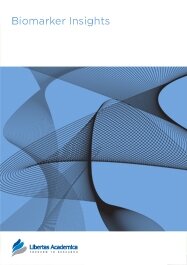

Publication Date: 22 Dec 2010
Type: Original Research
Journal: Biomarker Insights
doi: 10.4137/BMI.S6167

Background: Prognosis models established using multiple molecular markers in cancer along with clinical variables should enable prediction of natural disease progression and residual risk faced by patients. In this study, multivariate Cox proportional hazards analyses were done based on overall survival (OS) of 100 glioblastoma multiformes (GBMs, 92 events), 49 anaplastic astrocytomas (AAs, 33 events), 45 gliomas with oligodendroglial features, including anaplastic oligodendroglioma (AO, 13 events) and oligodendraglioma (O, 9 events). The modeling included two clinical variables (patient age and recurrence at the time of sample collection) and the expression variables of 13 genes selected based on their proven biological and/or prognosis functions in gliomas (ABCG2, BMI1, MELK, MSI1, PROM1, CDK4, EGFR, MMP2, VEGFA, PAX6, PTEN, RPS9, and IGFBP2). Gene expression data was a log-transformed ratio of marker and reference (ACTB) mRNA levels quantified using absolute real-time qRT-PCR.
Results: Age is positively associated with overall grade (4 for GBM, 3 for AA, 2_1 for AO_O), but lacks significant prognostic value in each grade. Recurrence is an unfavorable prognostic factor for AA, but lacks significant prognostic values for GBM and AO_O. Univariate models revealed opposing prognostic effects of ABCG2, MELK, BMI1, PROM1, IGFBP2, PAX6, RPS9, and MSI1 expressions for astrocytic (GBM and AA) and oligodendroglial tumors (AO_O). Multivariate models revealed independent prognostic values for the expressions of MSI1 (unfavorable) in GBM, CDK4 (unfavorable) and MMP2 (favorable) in AA, while IGFBP2 and MELK (unfavorable) in AO_O. With all 13 genes and 2 clinical variables, the model R2 was 14.2% (P = 0.358) for GBM, 45.2% (P = 0.029) for AA, and 62.2% (P = 0.008) for AO_O.
Conclusion: The study signifies the challenge in establishing a significant prognosis model for GBM. Our success in establishing prognosis models for AA and AO_O was largely based on identification of a set of genes with independent prognostic values and application of standardized gene expression quantification to allow formation of a large cohort in analysis.
PDF (711.74 KB PDF FORMAT)
RIS citation (ENDNOTE, REFERENCE MANAGER, PROCITE, REFWORKS)
BibTex citation (BIBDESK, LATEX)
XML
PMC HTML
I would like to extend my gratitude for creating the next generation of a scientific journal -- the science journal of tomorrow. The entire process bespoke of exceptional efficiency, celerity, professionalism, competency, and service.

All authors are surveyed after their articles are published. Authors are asked to rate their experience in a variety of areas, and their responses help us to monitor our performance. Presented here are their responses in some key areas. No 'poor' or 'very poor' responses were received; these are represented in the 'other' category.See Our Results
Copyright © 2013 Libertas Academica Ltd (except open access articles and accompanying metadata and supplementary files.)
FacebookGoogle+Twitter
PinterestTumblrYouTube